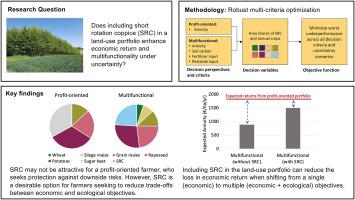Agricultural Systems ( IF 6.6 ) Pub Date : 2022-02-08 , DOI: 10.1016/j.agsy.2022.103372 Sebastian Rössert 1 , Elizabeth Gosling 1 , Markus Gandorfer 2 , Thomas Knoke 1

|
Context
Farmers are facing increasing pressure to practice multifunctional agriculture. Producing woody biomass through short rotation coppices (SRC) provides an economic opportunity for farmers to diversify their agricultural income while potentially providing environmental benefits.
Objective
Using multi-objective, robust optimization we investigate the extent to which SRC may help farmers to reconcile the economic objective of profit maximization with ecological concerns related to enhancing soil carbon and reducing the use of chemical inputs (nitrogen fertilizers and pesticides).
Methods
To evaluate the costs and benefits of SRC relative to conventional agricultural crops, we use empiric and modelled data from Bavaria, Germany. Based on this performance data our optimization model determines the best mix of land-uses (land-use portfolio) for reconciling multiple objectives under uncertainty. We compare the optimal portfolios for two decision perspectives: profit oriented (in which the decision-maker only considers economic return) and multifunctional (in which the three ecological objectives are considered in addition to economic return). Both perspectives consider that farmers seek protection against downside risks.
Results and conclusions
From the profit-oriented perspective, SRC was selected in the optimal portfolios (comprising 34% of the land area) derived for more risk-tolerant decision-makers, but was absent from the portfolio optimized for a strongly risk-averse decision-maker. Instead, higher woodchip prices may be required to make SRC economically attractive for strongly downside risk-averse farmers. In contrast, SRC was selected in the multifunctional portfolio (with 24-33% land-use shares) for all levels of risk aversion. We found that the selection of SRC helped to mitigate the financial costs of multifunctionality, increasing both the average and worst-case economic return of the multifunctional portfolio.
Significance
Our study reveals new insights concerning the influence of uncertainties and downside risk associated with SRC on anticipated farmer decisions and suggests that cultivating SRC can help reduce trade-offs between economic and ecological objectives.
中文翻译:

木片还是薯片?增加土壤碳和减少化学投入如何影响农田分配
语境
农民面临着越来越大的实行多功能农业的压力。通过短轮作林 (SRC) 生产木质生物质为农民提供了一个经济机会,使他们的农业收入多样化,同时可能提供环境效益。
客观的
使用多目标、稳健的优化,我们调查了 SRC 在多大程度上可以帮助农民将利润最大化的经济目标与与增加土壤碳和减少化学投入物(氮肥和杀虫剂)的使用相关的生态问题相协调。
方法
为了评估 SRC 相对于传统农作物的成本和收益,我们使用来自德国巴伐利亚的经验和建模数据。基于这些性能数据,我们的优化模型确定了土地利用的最佳组合(土地利用组合),以在不确定性下协调多个目标。我们比较了两个决策视角的最优投资组合:利润导向(决策者只考虑经济回报)和多功能(除了经济回报之外还考虑三个生态目标)。两种观点都认为农民寻求针对下行风险的保护。
结果和结论
从利润导向的角度来看,SRC 被选择在为更具风险承受能力的决策者派生的最佳投资组合中(占土地面积的 34%),但在为强烈规避风险的决策者而优化的投资组合中却没有。相反,可能需要更高的木片价格才能使 SRC 在经济上对强烈规避下行风险的农民具有吸引力。相比之下,SRC 被选入多功能投资组合(拥有 24-33% 的土地使用份额),以应对所有风险规避程度。我们发现选择 SRC 有助于降低多功能性的财务成本,增加多功能投资组合的平均和最坏情况下的经济回报。
意义
我们的研究揭示了有关与 SRC 相关的不确定性和下行风险对预期农民决策的影响的新见解,并表明培育 SRC 有助于减少经济和生态目标之间的权衡。


























 京公网安备 11010802027423号
京公网安备 11010802027423号